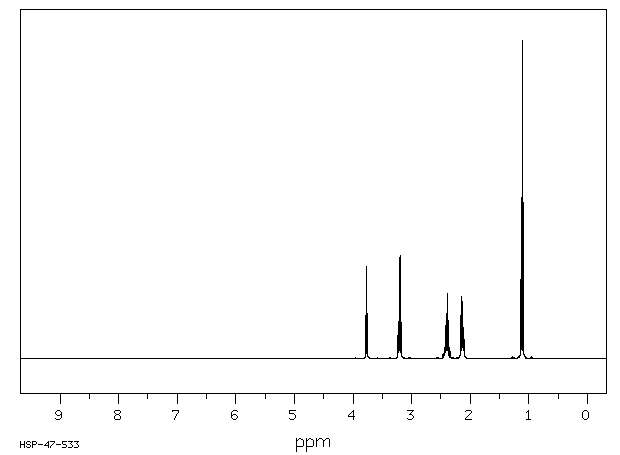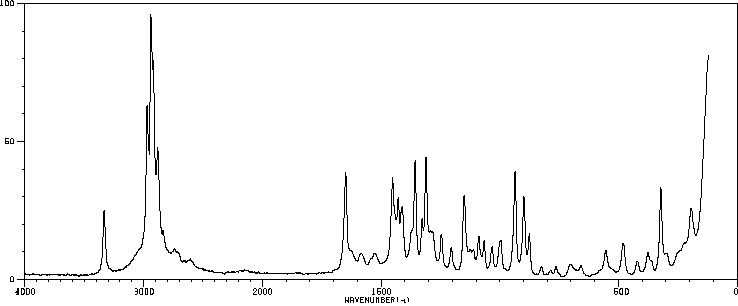茶氨酸 | 3081-61-6
-
物化性质
-
计算性质
-
ADMET
-
安全信息
-
SDS
-
制备方法与用途
-
上下游信息
-
文献信息
-
表征谱图
-
同类化合物
-
相关功能分类
-
相关结构分类
物化性质
-
熔点:207°C
-
沸点:430.2±40.0 °C(Predicted)
-
密度:1.171±0.06 g/cm3(Predicted)
-
溶解度:溶于水(高达 20 mg/ml)。
-
LogP:-0.661 (est)
-
物理描述:Solid
-
颜色/状态:White crystals from ethanol + water
-
气味:None (no odor)
-
味道:Astringent, sweet
-
蒸汽压力:5.0X10-8 mm Hg at 25 °C (est)
-
稳定性/保质期:
无臭,具有略带甜味的特殊风味,味觉阈值为0.15%。分解温度范围是214~215℃。
-
聚合:Product is considered stable and hazardous polymerization will not occur.
-
解离常数:pKa1 = 2.35 (acid); pKa2 = 9.31 (amine) (est)
计算性质
-
辛醇/水分配系数(LogP):-3.6
-
重原子数:12
-
可旋转键数:5
-
环数:0.0
-
sp3杂化的碳原子比例:0.71
-
拓扑面积:92.4
-
氢给体数:3
-
氢受体数:4
ADMET
安全信息
-
危险品标志:Xi
-
危险类别码:R43
-
海关编码:2924199090
-
安全说明:S28,S36/37
-
WGK Germany:3
-
危险标志:GHS07
-
危险性描述:H317
-
危险性防范说明:P280
-
储存条件:请将产品存放在阴凉干燥的环境中。
SDS
: L-Theanine
产品名称
1.2 鉴别的其他方法
L-Glutamic acid γ-(ethylamide)
Nγ-Ethyl-L-glutamine
1.3 有关的确定了的物质或混合物的用途和建议不适合的用途
仅供科研用途,不作为药物、家庭备用药或其它用途。
模块 2. 危险性概述
2.1 GHS分类
皮肤敏化作用 (类别1)
2.2 GHS 标记要素,包括预防性的陈述
象形图
警示词 警告
危险申明
H317 可能导致皮肤过敏反应。
警告申明
预防
P261 避免吸入粉尘/烟/气体/烟雾/蒸气/喷雾.
P272 禁止将受污染的工作服带出工作场地.
P280 戴防护手套。
措施
P302 + P352 如与皮肤接触,用大量肥皂和水冲洗受感染部位.
P321 具体治疗(见本标签上提供的急救指导)。
P333 + P313 如发生皮肤刺激或皮疹:求医/ 就诊。
P363 沾染的衣服清洗后方可重新使用。
处理
P501 将内容物/ 容器处理到得到批准的废物处理厂。
2.3 其它危害物 - 无
模块 3. 成分/组成信息
3.1 物 质
: L-Glutamic acid γ-(ethylamide)
别名
Nγ-Ethyl-L-glutamine
: C7H14N2O3
分子式
: 174.2 g/mol
分子量
组分 浓度或浓度范围
Nγ-Ethyl-L-glutamine
-
CAS 号 3081-61-6
EC-编号 221-379-0
模块 4. 急救措施
4.1 必要的急救措施描述
一般的建议
请教医生。 出示此安全技术说明书给到现场的医生看。
吸入
如果吸入,请将患者移到新鲜空气处。 如果停止了呼吸,给于人工呼吸。 请教医生。
皮肤接触
用肥皂和大量的水冲洗。 请教医生。
眼睛接触
用水冲洗眼睛作为预防措施。
食入
切勿给失去知觉者从嘴里喂食任何东西。 用水漱口。 请教医生。
4.2 主要症状和影响,急性和迟发效应
据我们所知,此化学,物理和毒性性质尚未经完整的研究。
4.3 及时的医疗处理和所需的特殊处理的说明和指示
无数据资料
模块 5. 消防措施
5.1 灭火介质
灭火方法及灭火剂
用水雾,耐醇泡沫,干粉或二氧化碳灭火。
5.2 源于此物质或混合物的特别的危害
碳氧化物, 氮氧化物
5.3 给消防员的建议
如必要的话,戴自给式呼吸器去救火。
5.4 进一步信息
无数据资料
模块 6. 泄露应急处理
6.1 人员的预防,防护设备和紧急处理程序
使用个人防护设备。 防止粉尘的生成。 防止吸入蒸汽、气雾或气体。 保证充分的通风。 避免吸入粉尘。
6.2 环境保护措施
不要让产物进入下水道。
6.3 抑制和清除溢出物的方法和材料
收集、处理泄漏物,不要产生灰尘。 扫掉和铲掉。 存放进适当的闭口容器中待处理。
6.4 参考其他部分
丢弃处理请参阅第13节。
模块 7. 操作处置与储存
7.1 安全操作的注意事项
避免接触皮肤和眼睛。 防止粉尘和气溶胶生成。
在有粉尘生成的地方,提供合适的排风设备。一般性的防火保护措施。
7.2 安全储存的条件,包括任何不兼容性
贮存在阴凉处。 容器保持紧闭,储存在干燥通风处。
7.3 特定用途
无数据资料
模块 8. 接触控制和个体防护
8.1 容许浓度
最高容许浓度
没有已知的国家规定的暴露极限。
8.2 暴露控制
适当的技术控制
按照良好工业和安全规范操作。 休息前和工作结束时洗手。
个体防护设备
眼/面保护
面罩與安全眼鏡请使用经官方标准如NIOSH (美国) 或 EN 166(欧盟) 检测与批准的设备防护眼部。
皮肤保护
戴手套取 手套在使用前必须受检查。
请使用合适的方法脱除手套(不要接触手套外部表面),避免任何皮肤部位接触此产品.
使用后请将被污染过的手套根据相关法律法规和有效的实验室规章程序谨慎处理. 请清洗并吹干双手
所选择的保护手套必须符合EU的89/686/EEC规定和从它衍生出来的EN 376标准。
身体保护
全套防化学试剂工作服, 防护设备的类型必须根据特定工作场所中的危险物的浓度和含量来选择。
呼吸系统防护
如须暴露于有害环境中,请使用P95型(美国)或P1型(欧盟 英国
143)防微粒呼吸器。如需更高级别防护,请使用OV/AG/P99型(美国)或ABEK-P2型 (欧盟 英国 143)
防毒罐。
呼吸器使用经过测试并通过政府标准如NIOSH(US)或CEN(EU)的呼吸器和零件。
模块 9. 理化特性
9.1 基本的理化特性的信息
a) 外观与性状
形状: 固体
b) 气味
无数据资料
c) 气味阈值
无数据资料
d) pH值
无数据资料
e) 熔点/凝固点
无数据资料
f) 起始沸点和沸程
无数据资料
g) 闪点
无数据资料
h) 蒸发速率
无数据资料
i) 易燃性(固体,气体)
无数据资料
j) 高的/低的燃烧性或爆炸性限度 无数据资料
k) 蒸汽压
无数据资料
l) 蒸汽密度
无数据资料
m) 相对密度
无数据资料
n) 水溶性
无数据资料
o) n-辛醇/水分配系数
辛醇--水的分配系数的对数值: -3.46
p) 自燃温度
无数据资料
q) 分解温度
无数据资料
r) 粘度
无数据资料
模块 10. 稳定性和反应活性
10.1 反应性
无数据资料
10.2 稳定性
无数据资料
10.3 危险反应的可能性
无数据资料
10.4 应避免的条件
无数据资料
10.5 不兼容的材料
强氧化剂
10.6 危险的分解产物
其它分解产物 - 无数据资料
模块 11. 毒理学资料
11.1 毒理学影响的信息
急性毒性
无数据资料
皮肤刺激或腐蚀
无数据资料
眼睛刺激或腐蚀
无数据资料
呼吸道或皮肤过敏
会引起过敏性皮肤反应。
前面的数据或数据判读是根据定量结构活性关系(QSAR)确定的。
生殖细胞突变性
无数据资料
致癌性
IARC:
此产品中没有大于或等于 0。1%含量的组分被 IARC鉴别为可能的或肯定的人类致癌物。
生殖毒性
无数据资料
特异性靶器官系统毒性(一次接触)
无数据资料
特异性靶器官系统毒性(反复接触)
无数据资料
吸入危险
无数据资料
潜在的健康影响
吸入 吸入可能有害。 可能引起呼吸道刺激。
摄入 如服入是有害的。
皮肤 如果通过皮肤吸收可能是有害的。 可能引起皮肤刺激。
眼睛 可能引起眼睛刺激。
接触后的征兆和症状
据我们所知,此化学,物理和毒性性质尚未经完整的研究。
附加说明
化学物质毒性作用登记: 无数据资料
模块 12. 生态学资料
12.1 生态毒性
无数据资料
12.2 持久存留性和降解性
无数据资料
12.3 潜在的生物蓄积性
无数据资料
12.4 土壤中的迁移性
无数据资料
12.5 PBT 和 vPvB的结果评价
无数据资料
12.6 其它不利的影响
无数据资料
模块 13. 废弃处置
13.1 废物处理方法
产品
将剩余的和未回收的溶液交给处理公司。 联系专业的拥有废弃物处理执照的机构来处理此物质。
与易燃溶剂相溶或者相混合,在备有燃烧后处理和洗刷作用的化学焚化炉中燃烧
受污染的容器和包装
作为未用过的产品弃置。
模块 14. 运输信息
14.1 联合国危险货物编号
欧洲陆运危规: - 国际海运危规: - 国际空运危规: -
14.2 联合国(UN)规定的名称
欧洲陆运危规: 非危险货物
国际海运危规: 非危险货物
国际空运危规: 非危险货物
14.3 运输危险类别
欧洲陆运危规: - 国际海运危规: - 国际空运危规: -
14.4 包裹组
欧洲陆运危规: - 国际海运危规: - 国际空运危规: -
14.5 环境危险
欧洲陆运危规: 否 国际海运危规 海运污染物: 否 国际空运危规: 否
14.6 对使用者的特别提醒
无数据资料
模块 15 - 法规信息
N/A
模块16 - 其他信息
N/A
制备方法与用途
茶氨酸是茶叶中的特征性氨基酸。 它主要由谷氨酸和乙胺在茶氨酸合成酶的作用下,在茶树根部合成,并对形成茶叶的滋味起着重要作用。其主要表现为鲜、甜,是茶叶生津润甜的主要成分之一。
研究表明,茶叶中鉴定出26种氨基酸(其中6种为非蛋白氨基酸),一般占茶叶干重的1%~5%,而茶氨酸则占游离氨基酸总量的50%以上。因此,它在茶叶中的含量显著高于其他氨基酸。
茶树氨基酸茶树含有26种氨基酸,其中包括20种与蛋白质有关的氨基酸(称为蛋白质氨基酸),还有6种与蛋白质合成无关的氨基酸(称为非蛋白质氨基酸)。在这6种中,最重要的就是茶氨酸。因此,茶氨酸是茶叶特有的氨基酸之一,并被认为是一种特征性氨基酸。
作为茶叶中含量最高的特征性非蛋白氨基酸,茶氨酸安全无毒副作用,具有多种生物活性,如抗氧化、调节免疫系统、延缓衰老和拮抗谷氨酸过量而产生的细胞兴奋性毒性等。 作为一种烷基胺,L-茶氨酸可以激活γ-T免疫细胞,促进细胞增殖和细胞因子分泌,增强抵抗肿瘤细胞的能力,并降低外界微生物的感染风险。
食用安全2014年7月18日,经批准,茶叶中的茶氨酸被列为新食品原料(公告号:2014年第15号)。根据规定,食用量应≤0.4克/天,并不适用于婴幼儿食品。
质量要求 鉴别试验取试样1克,加6摩尔/升盐酸10毫升,装上回流冷凝装置,在水浴中加热。然后按一定步骤进行石蕊试纸反应。
含量分析使用甲酸和冰醋酸溶解预干燥后的茶氨酸350毫克,并用结晶紫试液(TS-74)滴定0.1摩尔/升高氯酸至蓝绿色终点,以确定含量。每毫升0.1摩尔/升高氯酸相当于茶氨酸(C7Hl4N2O3) 17.42毫克。
化学性质天然品较多存在于上等绿茶中(可达2.2%)。
用途 生产方法生产步骤:由L-谷氨酸在高压下加热制得吡咯烷酮羧酸。将其制成铜盐后加入无水乙胺,在高压下加热得到L-茶氨酸。另一种方法是通过在高压下加热含有L-谷氨酸的溶液,加入无水氨基乙烷后再加热,最终获得L-茶氨酸。
上下游信息
-
上游原料
中文名称 英文名称 CAS号 化学式 分子量 DL-谷氨酰胺 GLUTAMIN 6899-04-3 C5H10N2O3 146.146 L-谷氨酰胺 L-glutamine 56-85-9 C5H10N2O3 146.146 Γ-谷氨酰-谷氨酰胺 γ-L-glutamyl-L-glutamine 10148-81-9 C10H17N3O6 275.261 -
下游产品
中文名称 英文名称 CAS号 化学式 分子量 甲酯茶氨酸 methyl ester theanine 1000788-95-3 C8H16N2O3 188.227 —— theanine ethyl ester —— C9H18N2O3 202.254 L-谷氨酰胺 L-glutamine 56-85-9 C5H10N2O3 146.146
反应信息
-
作为反应物:参考文献:名称:碘硝烯的作用:将氨基酸直接转化为末端二氮杂环和 15N2-二氮杂环及其作为超极化标记物的应用摘要:已经使用二乙酸苯基碘鎓 (PIDA) 和氨开发了一种将未受保护的氨基酸一锅无金属转化为末端二氮丙啶的方法。这种 PIDA 介导的转化通过三个连续的反应发生,并涉及碘化氮中间体。这种方法可以耐受氨基酸侧链上的大多数官能团,操作简单,可以放大以提供数克数量的二氮嗪。有趣的是,我们还证明了这种转化可以应用于没有外消旋化的二肽。此外,可以获得 14N2 和 15N2 同位素异构体,这强调了使用 15NH3 时的关键转亚胺化步骤。此外,我们报告了直接产生不对称碳的 14N/15N 同位素异构体的首次实验观察。最后,DOI:10.1021/jacs.9b07035
-
作为产物:描述:Z-L-theanine 在 20% palladium hydroxide-activated charcoal 、 氢气 作用下, 以 四氢呋喃 为溶剂, 反应 8.0h, 以100%的产率得到茶氨酸参考文献:名称:l-茶氨酸对海马神经元兴奋作用的表征:基于其骨干的新型N-甲基-d-天冬氨酸受体调节剂的产生摘要:l-茶氨酸(或l - γ - N-乙基-谷氨酰胺)是山茶中发现的主要氨基酸。由于其多效性的生理和药理活性特别是对人类健康有益,因此受到了广泛的关注。在这里,我们描述了一个新的,方便,高效和环境友好的化学合成升-theanine和升-γ- ñ丙基谷氨酰胺和它们对应的d异构体。到目前为止,l-茶氨酸及其衍生物在N-甲基-d处表现出部分拮抗作用。-天冬氨酸(NMDA)受体,对培养的海马神经元没有其他谷氨酸受体的激动作用。该活性保留在非洲爪蟾卵母细胞中表达的NMDA受体上。另外,含有1-甲基茶氨酸的NMDA受体的GluN2A和GluN2B均被1-茶氨酸同样地调节。如在培养的海马神经元上所测量的,从1-茶氨酸到d-茶氨酸的立体化学变化以及乙基取代1-和d-茶氨酸的γ- N位置上的丙基部分显着增强了生物学功效。升因此,-茶氨酸结构代表了开发新型NMDA受体调节剂的有趣骨架。DOI:10.1021/acschemneuro.7b00036
-
作为试剂:参考文献:名称:Beverage Packed in Sealed Container摘要:本发明的目的是提供一种装在密封容器中的饮料,可以抑制沉淀物的产生并保持高味道长时间不变。上述问题可以通过在500毫升饮料中含有(1)茶氨酸100毫克至1000毫克和(2)奎宁酸30毫克至300毫克来解决。公开号:US20070231444A1
文献信息
-
[EN] LEVORPHANOL PRODRUGS AND PROCESSES FOR MAKING AND USING THEM<br/>[FR] PROMÉDICAMENTS DE LEVORANOL ET LEURS PROCÉDÉS DE FABRICATION ET D'UTILISATION申请人:KEMPHARM INC公开号:WO2018191472A1公开(公告)日:2018-10-18The presently described technology provides compositions of one or more of oxoacids, polyethylene glycols, and vitamin compounds chemically conjugated to levorphanol ((-)-17-methylmorphinan-3-ol) to form novel prodrugs and compositions of levorphanol.
-
[EN] AMINO ACID DERIVATIVES AND THEIR USE AS FLAVOR MODIFIERS<br/>[FR] DÉRIVÉS D'ACIDES AMINÉS ET LEUR UTILISATION EN TANT QUE MODIFICATEURS DE GOÛT申请人:FIRMENICH & CIE公开号:WO2021209345A1公开(公告)日:2021-10-21The present invention provides derivatives of glutamine of formula (I) and derivatives of arginine of formula (II), and the use of such compounds as flavor modifiers. The invention further provides the use of such derivatives of glutamine and arginine to enhance the salty and umami taste of ingestible compositions as ingestible compositions that include such derivatives of glutamine and arginine and bulking agents.
-
γ-Glutamyl Transfer Reactions by Glutaminase from<i>Pseudomonas nitroreducens</i>IFO 12694 and Their Application for the Syntheses of Theanine and γ-Glutamylmethylamide作者:Takashi TACHIKI、Takeshi YAMADA、Katsushige MIZUNO、Masashi UEDA、Ju-ichi SHIODE、Hiroshi FUKAMIDOI:10.1271/bbb.62.1279日期:1998.1In a mixture containing γ-glutamyl donor (donor) and γ-glutamyl acceptor (acceptor), the glutaminase of Pseudomonas nitroreducens IFO 12694 simultaneously catalyzed a γ-glutamyl transfer reaction and hydrolysis of the donor. The variation of the activities responding to the concentration of glutathione and glycylglycine indicated that the enzyme might be classified in a group of glutaminases that shows hydrolysis prior to transfer reaction. On the other hand, the results with glutamine and ethylamine or methylamine indicated that the enzyme was active in the transfer reaction with suppressed hydrolysis of glutamine, and suggested the possibility of using the reaction for producing γ-glutamylethylamide (theanine) or γ-glutamylmethylamide (γ-GMA). In fact, in a mixture containing high concentrations of substrates (0.7 M glutamine, 1.5 M ethylamine or methylamine) and 0.5 unit/ml glutaminase (borate buffer pH 11), 270 mM (47 g/L) theanine or 250 mM (38 g/L) γ-GMA was formed in 7 h of incubation at 30°C.在一混合物中,含有γ-谷氨酰供体(供体)和γ-谷氨酰受体(受体),Pseudomonas nitroreducens IFO 12694的谷氨酰胺酶同时催化γ-谷氨酰转移反应和供体的裂解。谷胱甘肽和甘氨酰甘氨酸浓度对活性的变化表明,该酶可能属于一类谷氨酰胺酶,表现出裂解优先于转移反应。另一方面,谷氨酰胺和乙胺或甲胺的结果表明,该酶在转移反应中活跃,而谷氨酰胺的裂解被抑制,这提示了利用该反应生产γ-谷氨酰乙胺(茶氨酸)或γ-谷氨酰甲胺(γ-GMA)的可能性。实际上,在高浓度底物(0.7 M谷氨酰胺,1.5 M乙胺或甲胺)和0.5单位/毫升谷氨酰胺酶(硼酸盐缓冲液pH 11)的混合物中,在30°C下孵育7小时,形成了270 mM(47 g/L)的茶氨酸或250 mM(38 g/L)的γ-GMA。
-
Molecular Cloning and Characterization of γ-Glutamyltranspeptidase from<i>Pseudomonas nitroreducens</i>IFO12694作者:Masashi IMAOKA、Shigekazu YANO、Masashi OKUMURA、Takao HIBI、Mamoru WAKAYAMADOI:10.1271/bbb.100199日期:2010.9.23γ-Glutamyltranspeptidase from Pseudomonas nitroreducens IFO12694 (PnGGT) exhibited higher hydrolytic activity than transfer activity, as compared with other γ-glutamyltranspeptidases (GGTs). PnGGT showed little activity towards most of l-amino acids and towards glycyl-glycine, which is often used as a standard γ-glutamyl accepter in GGT transfer reactions. The preferred substrates for PnGGT as a γ-glutamyl accepter were amines such as methylamine, ethylamine, and isopropylamine.
-
FLAVOR MODULATOR HAVING PYRIDINE DERIVATIVE OR SALT THEREOF AS ACTIVE INGREDIENT申请人:T. HASEGAWA CO., LTD.公开号:US20180072670A1公开(公告)日:2018-03-152-(phenylalkyloxyalkyl)pyridine derivative or a 2-(phenylalkylthioalkyl)pyridine derivative imparts, when added to food and drink or cosmetics as an active ingredient, a flavor of natural impression thereto; and in particular, when added to food and drink, the compound imparts an umami imparting or enhancing, a saltiness enhancing a sweetness enhancing, and in particular, when added to a milk or dairy product, a food or drink product containing a milk or dairy product, or a dairy replacement product, the compound provides a milk richness enhancing.
表征谱图
-
氢谱1HNMR
-
质谱MS
-
碳谱13CNMR
-
红外IR
-
拉曼Raman
-
峰位数据
-
峰位匹配
-
表征信息










